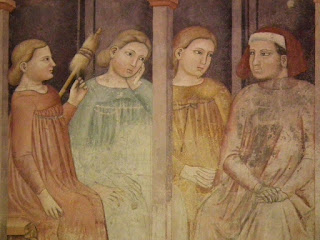Everybody knows (and loves, or ought to love) the high waisted gowns of the late
Quattrocento, however a waist placed even higher than most of the gowns from this period (except for some Venetian ones) was fashionable in Italy in the late 13th century and the first half of the 14th century. Mostly this effect was reached by tying a ribbon under the bust, but, there are some paintings that actually suggest that here were gowns with very short bodices and a gathered skirt.I have resisted this interpretation ever since I first saw these gowns, because it just doesn't fit in the general development of clothing in this period. But, as I will show in the end of this post, there are some paintings that I have a hard time explaining in any other way.
But, most of the high-waisted styles, are simply loose tunics tied under the bust:
Unknown master, 1270s
Simone Martini, Siena 1328:
Giotto, Padua Scrovegni chapel Padua 1303-1305
Woman in white to the right
The red gown appears to be tied with a string under the bust
In this one we see both a belt, to the left, and a more ambigious gown, which may well have a seam under the bust, to the right.
Here you can see the belt clearly:
Lippo di Benivieni, Madonna with child 1310-1320
Taddeo Gaddi, pregnant Madonna, 1340s-50s?
Ambrogio Lorenzetti c. 1335
Some of these appear to be either inspired by Roman styles, or, since this is before or early in the Renaissance, it may actually be a continuous tradition rather than copying of ancient statues. This woman, painted by Pietro Lorenzetti in the 1350s with both a tie under the bust and at the waist look very much like Roman statues.
As does the woman to the right in this late 1320s painting by Taddeo Gaddi:
Same fresco, look at the woman in lilac.
These gowns are cool also because they show a sewn fold on the gown, a detail that is mostly known from the 15th century.
More from the same fresco, look at the small women at the bottom right:
A good view of a belt on an image of St. Catherine painted by Pietro Lorenzetti 1342.
And another:
A toddler Mary with a gown tied with a narrow belt. 1330s
Often we don't see the ties of the belt, but they could be both in front as on St. Catherine and the attendant with towels above, and hanging down at the side, like on this painting by Pietro da Rimini where the woman to the left has a blue gown with a red belt with long end hanging down the side.
Then there are some that I can't say if it's a belt or a seam.
You can't see the belt in these from the late 13th or early 14th century Bologna, but from the shape of the bust I guess that it's a narrow belt or string tied just under the bust:
These gowns are more ambigious and it could be both a narrow tie or a seam.
More Bologna, this time St. Lucy in a painting by the so-called pseudo Jacopino, from 1329.
Pietro Lorenzetti, 1329. This is probably a high belt.
St. Agnes and St. Catherine in this painting, also by Pieto Lorenzetti, may wear gowns either with narrow gold coloured belts, or with gold trim at a high waist seam.
This one, by Ambrogio Lorenzetti, also Siena 1338-1339, does, however look more like it has a high waist seam, since the part under the horizontal line under the bust appears to be gathered. However, this could be the result of a tunic that fits snugly over the bust and widens a lot below the bust.
The same goes for these, from Castel San Pietro, Mendrisio (now in Switzerland) painted before 1345.
And then there's this one, by Giotto, from Padua, which mostly looks like it has a drawstring inside the gown (which is highly unlikely):
But then there are a few, which do look like there's a waist seam just under, or even on the bust (like when you buy tops intended for women without boobs and the underbust seam ends up right across your bust).
Leaf from a Cocharelli Treatise on the Vices, Accidia and Her Court, c. 1330
Buonamico Buffalmacco 1336-1341.
Look at the split surcoat of the woman on the right: no visible belt, but clear gathers of the "skirt".
Detail:
And then, what finally convinced me, those that I couldn't explain away: These frescoes from the turn of the century 1300, in San Zeno, Verona.
The final proof: In this image you actually see both seam and belt, since they don't align.
So, tentatively there appears to have been a variety of gown worn in northern and central Italy which had a high waist seam. As with the belted variety of this high-waisted look, which was more common, this style was more popular in the beginning of the 14th century and disappears, with a few Madonnas and saints as exceptions, in the second half of the century. Thus there is no clear connection between these fashions and the high waisted styles of the late 15th century.
The discussion in this blog post suffers from the fact that it is based only on visual soruces, since I don't have access either to written sources, such as wills and dowry records from this period. AFAIK there are also no studies of dress history specifically about this period and region; unlike the fashions of the 15th and 16th centuries.
I am very much looking forward to Elisa Tosi Brandis upcoming book on tailoring in medieval Italy.
But for now I think I am going to make an Italian gown with a high waist seam :)






























































